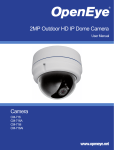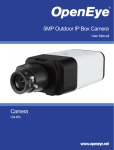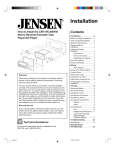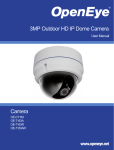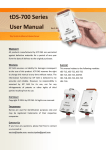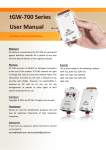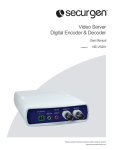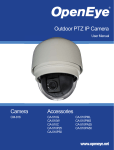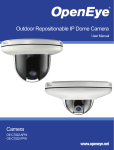Download 30250ad_openeye_cm
Transcript
2MP Outdoor HD IP Dome Camera User Manual Camera CM-715 CM-715A CM-715I CM-715IA www.openeye.net 2 Outdoor IP Camera (CM-715) User Manual Manual Edition 30250AD – September 2011 ©2000-2011, OPENEYE All Rights Reserved. No part of this documentation may be reproduced in any means, electronic or mechanical, for any purpose, except as expressed in the Software License Agreement. OpenEye shall not be liable for technical or editorial errors or omissions contained herein. The information in this document is subject to change without notice. The information in this publication is provided “as is” without warranty of any kind. The entire risk arising out of the use of this information remains with recipient. In no event shall OPENEYE be liable for any direct, consequential, incidental, special, punitive, or other damages whatsoever (including without limitation, damages for loss of business profits, business interruption or loss of business information), even if OPENEYE has been advised of the possibility of such damages and whether in an action or contract or tort, including negligence. This documentation is copyrighted. All other rights are reserved to OPENEYE. OPENEYE, and OpenEye, are registered trademarks of OPENEYE in the United States and elsewhere; Windows, and Windows XP Embedded are registered trademarks of Microsoft Corporation. All other brand and product names are trademarks or registered trademarks of the respective owners. OPENEYE Liberty Lake, WA ● U.S.A. 30250AD 3 Important Safeguards 1. Read Instructions Read all of the safety and operating instructions before using the product. 2. Retain Instructions Save these instructions for future reference. 3. Attachments / Accessories Do not use attachments or accessories unless recommended by the appliance manufacturer as they may cause hazards, damage product and void warranty. 4. Installation Do not place or mount this product in or on an unstable or improperly supported location. Improperly installed product may fall, causing serious injury to a child or adult, and damage to the product. Use only with a mounting device recommended by the manufacturer, or sold with the product. To insure proper mounting, follow the manufacturer's instructions and use only mounting accessories recommended by manufacturer. 5. Power source This product should be operated only from the type of power source indicated on the marking label. Precautions Operating • Before using, make sure power supply and others are properly connected. • While operating, if any abnormal condition or malfunction is observed, stop using the camera immediately and then contact your local dealer. Handling 4 • Do not disassemble or tamper with parts inside the camera. • Do not drop or subject the camera to shock and vibration as this can damage camera. • Do not block the cooling holes on the bracket. This camera has a cooling fan inside the housing. Blocking the cooling holes will cause heat to build up and cause malfunction. • Care must be taken when you clean the clear dome cover. Scratches and dust will ruin the image quality of your camera. Do not use strong or abrasive detergents when cleaning the camera body. Use a dry cloth to clean the camera when it is dirty. In case the dirt is hard to remove, use a mild detergent and wipe the camera gently. Installation and Storage • Install electricity wiring carefully. Please note that input electricity to the unit is at tolerance of DC 12V/AC 24V ± 10%. The camera is capable of surge protection; ensure AC power model unit is grounded appropriately against damage by heavy current or electric shock. • Do not install the camera in areas of extreme temperatures in excess of the allowable range. ( -31°F ~ 122°F / -35°C ~ 50°C) • Avoid installing in humid or dusty places. The relative humidity must be below 90%. • Avoid installing in places where radiation is present. • Avoid installing in places where there are strong magnetic fields and electric signals. • Avoid installing in places where the camera would be subject to strong vibrations. • Never face the camera toward the sun. Do not aim at bright objects. Whether the camera is in use or not, never aim it at the sun or other extremely bright objects. Otherwise the camera may be smeared and damaged. Regulation This device complies with Part 15 of the FCC Rules. Operation is subject to the following two conditions: (1) this device may not cause harmful interference, and (2) this device must accept any interference received, including interference that may cause undesired operation. This symbol on the product or on its packaging indicates that this product shall not be treated as household waste in accordance with Directive 2002/96/EC. Instead it shall be handed over to the applicable collection point for the recycling of electrical and electronic equipment. By proper waste handling of this product you ensure that it has no negative consequences for the environment and human health, which could otherwise be caused if this product is thrown into the garbage bin. The recycling of materials will help to conserve natural resources. For more details information about recycling of this product, please contact your local city office, your household waste disposal service or the shop where you purchased the product. Compliance is evidenced by written declaration from our suppliers, assuring that any potential trace contamination levels of restricted substances are below the maximum level set by EU Directive 2002/95/EC, or are exempted due to their application. 30250AD 5 Warning DANGEROUS HIGH VOLTAGES ARE PRESENT INSIDE THE ENCLOSURE. DO NOT OPEN THE CABINET. REFER SERVICING TO QUALIFIED PERSONNEL ONLY. Caution CAUTION RISK OF ELECTRIC SHOCK DO NOT OPEN CAUTION: TO REDUCE THE RISK OF ELECTRIC SHOCK, DO NOT REMOVE COVER (OR BACK). NO USER-SERVICEABLE PARTS INSIDE. REFER SERVICING TO QUALIFIED SERVICE PERSONNEL. 6 Standard Warranty OpenEye warrants all new products to be free from defects in workmanship and material under normal use for a period of two years after the date of purchase. Any defective product that falls under this warranty will, at OpenEye's discretion, be repaired or replaced at no additional charge. OpenEye may elect to replace defective products with new or factory reconditioned products of equal or greater value. Repairs made necessary by reason of misuse, alteration, normal wear, or accident are not covered under this warranty. Exceptions to this are listed below: • Three Years on all Digital Recorders • Three years on all analog fixed cameras All products shall be covered by a one year advance replacement warranty*. OpenEye will warrant all otherwise out of warranty replacement parts and repairs for 90 days from the date of OpenEye shipment. The above warranty is the sole warranty made by OpenEye and is in lieu of all other warranties by OpenEye express and implied, including without limitation the warranties of merchantability and fitness for a particular purpose. Under no circumstances will OpenEye be liable for any consequential, incidental, special or exemplary damages arising out of or connected with the sale, delivery, use or performance of the product, even if OpenEye is apprised of the likelihood of such damages occurring. In no event shall OpenEye liability exceed the purchase price of the product. This warranty gives you specific legal rights and you may also have other rights which vary from state to state or country to country. This warranty does not apply to products purchased through unauthorized sales channels. View OpenEye’s full policy on unauthorized product sales at openeye.net. *Requires corresponding security deposit. Advanced Replacement limited to components only outside of the USA and Canada. 28574AH For the most up to date information visit www.openeye.net 30250AD 7 TABLE OF CONTENTS Table of Contents ..................................................................................... 8 Introduction ............................................................................................ 11 Overview ....................................................................................................................... 11 Product Features ...................................................................................................... 11 Getting Started ....................................................................................... 12 Box Contents ................................................................................................................ 12 Camera Overview ......................................................................................................... 13 Dimensions ............................................................................................................... 13 Connections .............................................................................................................. 14 Installation .............................................................................................. 15 Power and Ethernet Connection ................................................................................... 15 Power Connection .................................................................................................... 15 Ethernet Cable Connection ...................................................................................... 15 Ceiling Installation ......................................................................................................... 16 4S Electrical Box Installation ........................................................................................ 22 Camera Finder ........................................................................................ 25 OpenEye IP Finder ....................................................................................................... 25 Finding IP Cameras .................................................................................................. 25 Default Username and Password ........................................................................ 25 Changing the Network Type ..................................................................................... 26 Setup & Configuration ........................................................................... 26 Connecting to the Camera ............................................................................................ 26 Resetting the Camera............................................................................................... 26 Administrator/User Privileges ................................................................................... 26 Connecting a Stream ................................................................................................ 27 Connecting Over the Internet ................................................................................... 28 Viewer Software ............................................................................................................ 29 Viewer Tabs .............................................................................................................. 29 8 Home ........................................................................................................................ 30 CM-715 and CM-715I Models .............................................................................. 30 CM-715A and CM-715AI Models ......................................................................... 31 System ...................................................................................................................... 32 System ................................................................................................................. 32 Security ................................................................................................................ 33 Admin Password .............................................................................................. 33 Add User .......................................................................................................... 34 Delete user ...................................................................................................... 34 Edit user ........................................................................................................... 34 Network ................................................................................................................ 35 Get IP address automatically (DHCP) ............................................................. 35 Use fixed IP address........................................................................................ 35 DDNS ................................................................................................................... 37 Mail ....................................................................................................................... 38 FTP....................................................................................................................... 39 Application ............................................................................................................ 40 Motion Detection .................................................................................................. 42 Storage Management........................................................................................... 46 Recording ............................................................................................................. 47 Snapshot .............................................................................................................. 48 View Log File ........................................................................................................ 49 View User Information .......................................................................................... 50 View User Login Information ........................................................................... 50 View User Privilege.......................................................................................... 50 View Parameters .................................................................................................. 51 Factory Default ..................................................................................................... 52 Set Default ....................................................................................................... 52 Reboot ............................................................................................................. 52 Software Version .................................................................................................. 53 Software Upgrade ................................................................................................ 54 Upgrading the Camera Viewer Software ......................................................... 54 Maintenance ......................................................................................................... 56 Video and Audio Streaming Settings ........................................................................ 57 Video Format ........................................................................................................ 57 30250AD 9 Text Overly Settings ........................................................................................ 57 Video Rotate Type ........................................................................................... 58 Video Compression .............................................................................................. 59 Video OCX Protocol ............................................................................................. 60 Multicast Mode ................................................................................................. 60 Frame Rate Control.............................................................................................. 61 Video Mask .......................................................................................................... 62 Audio .................................................................................................................... 63 Transmission Mode ......................................................................................... 63 Bit Rate ............................................................................................................ 64 Camera ..................................................................................................................... 65 Exposure .............................................................................................................. 65 White Balance ...................................................................................................... 66 Brightness ............................................................................................................ 66 Sharpness ............................................................................................................ 66 Contrast ................................................................................................................ 66 Saturation ............................................................................................................. 67 Digital Zoom ......................................................................................................... 67 IR Function ........................................................................................................... 67 TV System ............................................................................................................ 67 Logout ....................................................................................................................... 67 Specifications......................................................................................... 68 Camera Specifications .................................................................................................. 68 IR Specifications ........................................................................................................... 70 IP Specifications ........................................................................................................... 70 10 INTRODUCTION OVERVIEW OpenEye’s 700-Series high resolution outdoor IP dome cameras provide superior video quality and design. With features such as full HD 1080p 2 megapixel resolution and a tamper resistant design, the CM-715 camera is a smart choice for outdoor surveillance applications. The CM-715A model has all the same features as the CM-715, with the addition of an auto-focus lens making installation quick and easy. The CM-715I includes 23 infrared LEDs for enhanced nighttime viewing, and the CM715AI model has both the IR LEDs and the auto-focus lens. Designed for tough environments where standard security cameras are not suited to survive, the CM-715 is equipped with a heater allowing operation in temperatures as low as -31°F (-35°C). The CM-715 camera can be connected to both 24vAC and 12vDC power or to a PoE switch but 24vAC power is required to operate the on-board heater. Product Features 30250AD • Aptina Progressive CMOS image sensor • H.264/ MJPEG video streaming • Resolution: 2MP (1080p), HD 720p, D1, VGA, QVGA, CIF, QCIF • Frame Rate: 2MP transmits at 15 ips, all other resolutions transmit 25/30ips real time • Image Settings: Rotation: Flip, Mirror, and 180° Rotate Brightness, Sharpness, Contrast, White Balance, Exposure Control • Built-in IR Cut Filter • Two-way audio support • Weatherproof (IP66 international standard) • Security Torx screws protect against tampering • 3-axis (pan/tilt/rotation) position adjustment • Built-in heater and fan • 4S mount support 11 GETTING STARTED BOX CONTENTS Before proceeding, please check that the box contains the items listed here. If any item is missing or has defects, DO NOT install or operate the product and contact your dealer for assistance. CM-715 Camera 12 Power Cable Self Tapping Screws Plastic Anchors Security Torx Tool Rubber Washers Quick Start Guide CD CAMERA OVERVIEW Before installing or connecting the dome camera, please refer to this section and complete preparations for dome setup and all switch settings. Dimensions 30250AD • Diameter – 151 mm (5.9 inches) • Height – 130 mm (5.12 inches) 13 Connections Item Pin Definition Reset - Restore Factory Default Settings BNC - Analog Video Output Alarm I/O 1 Alarm Output 2 Alarm Output 3 Alarm Input 4 Alarm Input 1 Input 2 GND 3 Output (R) 4 Output (L) RJ45 - 10/100 Ethernet PoE Power 12vDV / 24vAC 1 Power (+) 2 GND 3 Power (-) Audio I/O 14 INSTALLATION POWER AND ETHERNET CONNECTION Read the installation instructions before installing and connecting the IP camera. Power Connection You can use 12vDC power, 24vAC power or Power over Ethernet (PoE) to power the CM715 camera. When powered by PoE, any 802.3af compliant device may be used to provide power. When using 12vDC or 24vAC power, refer to the pin definition table in the Camera Overview > Connections section for the proper 2-wire connection. Note OpenEye recommends against using more than one power source at a time. Do not use a PoE power source when providing the camera with 12vDC or 24vAC power. However, only 24vAC power will properly power the heater in the camera. If the camera is not subjected to temperatures lower than 40°F, a heater is not necessary and 24vAC, 12vDC or PoE (using an injector or compliant switch) will be suitable. Please verify that all installations that require a heater use 24vAC power. Make sure the camera’s power cable is correctly and firmly connected. If using Power over Ethernet (PoE), make sure Power Sourcing Equipment (PSE) is in use in the network. Ethernet Cable Connection OpenEye recommends using Category 5 Ethernet cable to connect the camera to your network. For the best transmission quality, the cable length should not exceed 328 feet (100 meters). Connect a network cable to the camera using the RJ45 input and connect the other end of the cable to your network switch or DVR. Note If you are connecting the camera directly to a DVR, a crossover cable is necessary for most configurations. Check the status of the network connection by looking at the link indicator and activity indicator LEDs. If the LEDs are not lit check your network connection. The green link LED indicates a network connection and the orange activity LED flashes to indicate network activity. 30250AD 15 CEILING INSTALLATION The IP Dome Camera can be installed directly on a wall or ceiling. That the wall or ceiling must have enough strength to support the IP Dome Camera. 16 1. Use the supplied Torx tool to unscrew the two Torx screws on the side of the dome cover and remove the dome cover. 2. Press both sides of the Inner Cover and remove it from the Dome Camera. 30250AD 3. Unscrew the Torx screw on the camera module, as indicated in the figure, with the supplied Torx tool. 4. Press the sides of the snap-on module, as indicated in the figure, and detach it from the Dome Camera’s housing. 5. Mark the positions of the four screw holes on the base of the Dome Camera at the chosen installation location. 6. In the marked locations, drill each hole slightly smaller than the supplied screw anchors. 7. Insert the supplied anchors into the drilled holes. 17 8. Fasten the camera housing to the ceiling with the supplies screws 9. Thread the power and Ethernet cables through the side conduit entry or the back conduit entry. Note The power cable is omitted if using PoE. 10. Connect the power and Ethernet connectors on the camera with their respective cables. 18 11. Attach the snap-on module to the camera housing, and screw the module screw tightly with the Security Torx to secure the camera module. Note The terminal blocks should face the side conduit entry, as shown in the figure. 12. Use the OpenEye IP Finder software to locate the camera on the network and complete configuration of the camera. 13. After connecting to the camera, adjust the camera's zoom level and focal length using the zoom and focus ring screws. 30250AD 19 14. Adjust the camera to the desired angle. Pan adjustment range is nearly 360°; rotation angle range approaches to 270°. Tilt is adjustable between ﹣ 10° ~ 90°. Pan Adjustment Note Rotation Adjustment Tilt Adjustment Adjust the lens carefully within the limits mentioned above, or the cables underneath will be damaged. 15. Replace the Inner Dome cover. 16. Replace the dome cover, aligning the arrow mark on the dome cover with the one on the housing. 20 17. Screw the two Torx screws on the side of the dome cover tightly to fasten the dome cover. 30250AD 21 4S ELECTRICAL BOX INSTALLATION Before installing the camera in a 4S Electrical Box, unscrew and open the dome cover with the Security Torx. 1. Run the wires (Ethernet and power) through the wall to the 4S box. Note 2. 22 The Power Cable is omitted if using PoE. Press both sides of the Inner Cover and remove it from the Dome Camera. 30250AD 3. Unscrew the Torx screw on the camera module, as indicated in the figure, with the supplied Torx tool. 4. Press the sides of the snap-on module, as indicated in the figure, and detach it from the Dome Camera’s housing. 23 5. Thread the power and Ethernet cables through either the side conduit entry or back conduit entry. Then fasten the Dome Camera’s housing to the Electrical Box with the two screws. 6. Connect the power and Ethernet cables to their connectors on the Dome Camera unit. 7. Attach the snap-on module to the camera housing, and screw the module screw tightly with the Security Torx to secure the camera module. 8. Use the OpenEye IP Finder software to locate the camera on the network and complete configuration of the camera. 9. After connecting to the camera, adjust the camera's zoom level and focal length using the zoom and focus ring screws. 10. Replace the inner dome cover. 11. Replace the dome cover, aligning the arrow mark on the dome cover with the one on the housing. 12. Screw the two Torx screws on the side of the dome cover tightly to fasten the dome cover. 24 CAMERA FINDER OPENEYE IP FINDER Use the included IP Finder software to easily find your network cameras for initial setup. The OpenEye IP Finder software is included on the CD with all OpenEye IP devices. Finding IP Cameras 1. Open the Software CD on the recorder. 2. Click Software on the software disc menu. 3. Click OpenEye IP Finder. 4. Click Device Search on the Device Search window. 5. If a Windows Security Alert window opens, click Unblock to allow the IP utility to access your network. 6. Click Device Search again to find all connected IP devices. Tip The default IP address of the CM-715 is 192.168.0.250 7. Right-click the desired network device and select Browse. 8. Type the default username and password in the login window to access the video server using your internet browser. Default Username and Password The username and password are case sensitive. It is strongly recommended that the password be changed after the initial setup to prevent unauthorized access. Username – Admin Password – 1234 30250AD 25 Changing the Network Type You can change the network type from Static IP to DHCP easily from the list of connected IP devices. To change the network type to DCHP: 1. On the list of connected IP devices locate the desired camera and record the MAC address, 2. Right-click the camera row and select Network Setup. 3. Select the DCHP option on the Network Setup window and then click Apply. 4. Click OK to acknowledge the change. 5. After one minute, click Device Search to search for all connected IP devices. 6. Locate the camera using the MAC address recorded earlier and double click the camera row. 7. Type the Username and Password to access the camera. SETUP & CONFIGURATION CONNECTING TO THE CAMERA 1. Locate the camera on the IP Finder list. 2. Double-click the camera to open the Viewer software in your web browser. 3. Log in to the camera with the appropriate User Name and Password. Note The default User name is Admin and the default Password is1234. The username and password are case sensitive. OpenEye recommends you change the Admin password for security reasons. Resetting the Camera If it is necessary to reset the camera to the factory default settings, hold down the Reset button (see Connections) for 30 seconds. This will return all settings, including network setup, to the factory default. The IP address of the camera will return to 192.168.0.250. Administrator/User Privileges The Administrator account has the authority to configure the IP camera and authorize users’ access to the camera. The User accounts have access to the camera with limited authority. 26 Connecting a Stream OpenEye IP cameras are optimized for use with OpenEye recorders, but you can also connect to your OpenEye IP cameras using third party software like VLC media player (http://www.videolan.org). To connect the camera you may need to provide the stream URL. All OpenEye IP cameras are capable of delivering two RTSP streams, as well as streaming MJPEG over HTTP. The stream URLs are listed below. rtsp://<ip address>/mjpeg rtsp://<ip address>/mpeg4 rtsp://<ipaddress>/h264 http://<ipaddress>:8008 The MJPEG over HTTP stream is identified by a port number. The default port is 8008; this port can be configured in the cameras Network page: 30250AD 27 Connecting Over the Internet There are some challenges with connecting to OpenEye IP cameras over WAN (internet) connections because the camera streams video over RTSP. RTSP is an excellent protocol for media and is now used on many IP cameras (including OpenEye) as the default streaming option. However, RTSP is not suitable for transmission between two locations that are behind different routers. In this case, the client (for example, the OpenEye HVR or NVR server software) connects to the camera, then requests a stream. The camera uses that connection to return a stream, but since the connection originated on the client side and has now switched to the camera (remote) side, the router does not have any way to determine where the traffic should be routed, so no video appears at the recorder. There are three solutions to this: 1. Connect modems on both sides directly to the recorder and camera. If there is no router, no network address translation is needed. 2. Use routers with VPN support and set up a small VPN. Once this is done, the traffic will be treated as though it were all on the local network. 3. (Best solution) – Use routers with connection tracking. This is quite easy; VOIP also uses RTSP and faces the same challenges. If a router is marketed as having “VOIP Support”, it will have the necessary connection tracking capability to allow any type of RTSP communication (not just VOIP). With proper planning and the correct equipment, RTSP cameras CAN stream over the WAN to a recording device for minimal additional cost and labor. Please contact OpenEye support if you require any additional information on these topics. 28 VIEWER SOFTWARE To access the setup menu, you need to install the viewer software on your PC or DVR. The viewer software will install automatically the first time you connect to the camera. If your internet browser doesn’t install the viewer software, check the security settings or ActiveX controls and plug-in settings. For additional information on adjusting the settings of your Internet Explorer browser contact your system administrator or refer to FAQ #1914 at openeye.net If your internet browser asks for permission to install the ActiveX control, you must allow the ActiveX control to continue the installation. The first time you connect to a camera, the browser will ask for permission to install the ActiveX Control necessary to display the camera video. Right-click the information bar and click Install ActiveX Control to allow the installation. Viewer Tabs Home – Monitor live video. System – Set the host name, system time, root password, and network related settings. (Admin access only) Streaming – Modify the video resolution and select the audio compression type. Camera – Adjust the camera parameters including Exposure, White Balance, Brightness, Sharpness, Contrast, and Digital Zoom. 30250AD 29 Logout – Change user. Home CM-715 and CM-715I Models Screen Size Adjustment – Click the screen size buttons to adjust image display size x1/2 and full screen. Digital Zoom Control – In full screen mode, right-click to activate digital zoom and use the scroll wheel to zoom in/out. Talk – Talk allows the local site to talk to the remote site. This function is only available to Users who have been granted this privilege by the Administrator. Snapshot – Click the button, and a JPEG snapshot will automatically be saved in the appointed place. The default location is: C:\. Note 30 If you are using Windows Vista or 7, you will need to change the Snapshot location. Windows UAC does not allow internet programs to write directly to C:\ for security reasons. CM-715A and CM-715AI Models The CM-715A is equipped with a motorized autofocus lens that makes installation quick and easy. There are six main buttons that are used when setting up the CM-715A: • Zoom Tele • Zoom Wide • Focus Near • Focus Far • Push AF • Reset Use these buttons to control the camera’s zoom and focus. Click Push AF to automatically focus the camera. The camera will keep this focus setting until it receives another command. Once the CM-715A is installed in the preferred location, use the Zoom and Focus buttons to set the camera’s field of view and then click the Push AF button to focus the camera. To return the lens to the default setting, click Reset. 30250AD 31 System Note The System tab is only accessible by the Administrator. System Host Name – The Host Name is used to identify the camera on your system. If camera based Motion Detection is enabled and is set to send alarm message by Mail/FTP, the host name entered here will display in the alarm message. Time Zone – Select your time zone. Sync With Computer Time – Select to synchronize the camera date and time with the connected PC or DVR. Manual – Set video date and time manually. Sync with NTP server – Network Time Protocol (NTP) is an alternate way to set your camera’s clock by synchronizing with an NTP server. Specify the server you wish to synchronize in the NTP Server box. Then select an Update Interval. For more information about NTP, visit www.ntp.org. 32 Security Admin Password To change the administrator password, type a new password in the Admin Password box and confirm below. Note 30250AD The maximum length of the password is 14 characters. The following characters are valid: A-Z, a-z, 0-9, !#$%&’-.@^_~. 33 Add User The user name and passwords are limited to 16 characters. There is a maximum of twenty user accounts 1. Type the new User name and Password 2. Select the appropriate check boxes to give the user Camera Control, Talk and Listen permissions. I/O access – Basic functions that enable users to view video when accessing to the camera. Camera control – Allows the User to change camera parameters on the Camera tab. Talk/Listen – Talk and Listen functions allow the user at the local site (DVR) to communicate with, the administrator at the remote site. 3. Click Add. Delete user 1. Select the user name on the User Name list 2. Click Delete to remove the user. Edit user 34 1. Select the user name on the User Name list 2. Click Edit to edit the user password and permissions. 3. Type a new password or the existing password in the User password box Note You must type a password in the User password box to make any changes to an account. Note For security reasons every time the user properties are opened, the access check boxes are automatically cleared. Make sure you select any user access options each time you edit the user properties. Network You can choose to use a fixed IP address or a dynamic IP address (assigned by a DHCP server or router) for the camera. Get IP address automatically (DHCP) The camera comes preconfigured with a fixed IP address. Note Every network device has a unique Media Access Control (MAC) address that can be used for identification. The MAC address is located on the bottom of each camera, and on the box label (the OpenEye IP Finder also displays the MAC address for identification). Record your camera’s MAC address for identification in the future. Use fixed IP address To set up a new static IP address: 30250AD 1. Select the Use fixed IP address option. 2. Type a new IP address in the IP address box. 3. Type a new address in the Default Gateway box. 4. Click Save to confirm the new setting. 35 When using static IP address to log in to the IP Camera, you can access it either through OpenEye IP Finder software or type the IP address directly in the Address bar of your internet browser. General • IP address – The IP Address is necessary for network identification. • Subnet mask – Used to determine if the destination is in the same subnet. The default value is 255.255.255.0. • Default gateway – Used to forward frames to destinations on different subnets or for internet access. • Primary DNS – The primary domain name server that translates hostnames into IP addresses. • Secondary DNS – A secondary domain name server that backups the primary DNS. • Web Server port – Defines the port that Internet Explorer uses to connect over the web and view video. If this port is changed then the new port must be defined when attempting to web connect (ex: if your camera’s IP address is 192.168.0.100 and you change the web port to 8001, then you must type http://192.168.0.100:8001 in your browser). Advanced • RTSP port – The default RTSP port is 554; setting range: 1024 ~65535. • MJPEG over HTTP port – The default HTTP Port is 8008; setting range: 1024 ~65535. Note 36 The MJPEG over HTTP port cannot be the same as the web server port. DDNS DDNS (Dynamic Domain Name Service) is a service that allows a connection to an IP address using a hostname (URL) address instead of a numeric IP address. Most Internet Service Providers use Dynamic IP Addressing that frequently changes the public IP address of your internet connection; this means that when connecting to the camera over the internet, you need to know if your IP address has changed. DDNS automatically redirects traffic to your current IP address when using the hostname address. • 30250AD Enable DDNS – Select the check box to enable DDNS. • Provider – Select a DDNS host from the Provider list. • Host name – Type the registered domain name in the field. • Username/E-mail – Type the username or e-mail required by the DDNS provider for authentication. • Password/Key – Type the password or key required by the DDNS provider for authentication. 37 Mail The camera can send an e-mail via Simple Mail Transfer Protocol (SMTP) when motion is detected or when the sensor input is activated. SMTP is a protocol for sending e-mail messages between servers. SMTP is a relatively simple, text-based protocol, where one or more recipients of a message are specified and the message text is transferred. The configuration page is shown as follows: Two sets of SMTP accounts can be configured. Each set includes SMTP Server, Account Name, Password and E-mail Address settings. For SMTP server, contact your network service provider for more specific information. 38 FTP The camera can send alarm message to a specific File Transfer Protocol (FTP) site when motion is detected or when the sensor input is activated. You can assign alarm message to up to two FTP sites. 30250AD 1. Enter the FTP details, which include server, server port, user name, password and remote folder, in the appropriate boxes. 2. Click Save when finished. 39 Application The CM-715 is equipped with one alarm input and one relay output to connect to an alarm system to catch event images. Refer to Camera Overview > Connections to connect alarm devices to the IP Camera if needed. Alarm Switch – Enable or disable the alarm function. Alarm Type – Select an alarm type, “Normal close” or “Normal open,” that corresponds with the alarm application. Alarm Output – Define alarm output signal “high” or “low” as the normal alarm output status according to the current alarm application. Triggered Action (Multi-option) – Specify alarm actions that will take place when the alarm is triggered. 40 • Enable Alarm Output – Select to enable relay output on alarm. • Send Alarm Message by FTP/E-Mail – Select to send an alarm message to a configured FTP and/or E-Mail address when an alarm is triggered. When sending to email, the alarm notification is text only. When sending to FTP, the alarm notification will upload a text file to the FTP location. • Upload Image by FTP – Select to assign an FTP site. When the alarm is triggered, event images will be uploaded to the configured FTP site at the rate of one jpeg image per second. • Upload Image by E-Mail – Select to assign an e-mail address. When the alarm is triggered, event images will be sent to the configured e-mail address. Note Make sure SMTP or FTP configuration has been completed. See the Mail and FTP section of this manual for further details. File Name – Enter a file name in the box, ex. image.jpg. The uploaded image’s file name format can be set in this section. Please select the one that meets your requirements. • Add date/time suffix File name: imageYYMMDD_HHNNSS_XX.jpg Y: Year, M: Month, D: Day H: Hour, N: Minute, S: Second X: Sequence Number • Add sequence number suffix (no maximum value) File name: imageXXXXXXX.jpg X: Sequence Number • Add sequence number suffix (limited value) File Name: imageXX.jpg X: Sequence Number The file name suffix will end with the value entered in this box. For example, if the setting is up to “10,” the file name will start from 00, end at 10, and then start all over again. Overwrite – The original image on the FTP site will be overwritten by the new uploaded file with a static filename. 30250AD 41 Motion Detection Motion Detection allows the camera to detect motion and trigger alarms when motion in the detected area exceeds the determined sensitivity threshold value. In the Motion Detection page, there is a motion detection window (red box) displayed on the Live View Pane. The Motion Detection window defines the motion detection area. To change the size of the Motion Detection window, drag the edge of the frame to resize. You can add up to 10 motion detection windows. 42 • Click add under the Live View Pane to add a Motion Detection window. • To delete a Motion Detection window, use the mouse to select the frame and click delete. When motion detection is activated, the Motion pop-up window will open. When motion is detected, the signals will be displayed on the Motion window as shown below. Motion Detection Turn motion detection on or off. The default setting is Off. Motion Detection Setting 30250AD • Sampling pixel interval [1-10] – Default value is 10, which means system will take one sampling pixel for every 10 pixels. • Detection level [1-100] – Default detection level is 10. This item sets the detection level for each sampling pixel; the smaller the value, the more sensitive it is. • Sensitivity level [1-100] – The default sensitivity level is 80, which means if 20% or more sampling pixels are detected as changed, the system will detect motion. The bigger the value, the more sensitive it is. As the sensitivity value is increased, the red horizontal line in the motion indication window will be lowered accordingly. • Time interval (sec) [0-7200] – The default interval is 10. The value is the interval between each detected motion event. 43 Triggered Action You can specify which actions the camera should take when motion is detected. • Enable Alarm Output – This will activate the camera’s alarm output. • Send Alarm Message by FTP/E-Mail – Select to send an alarm message to a configured FTP server and/or e-mail address when motion is detected. When sent to e-mail, the alarm notification is text only. When sending to FTP, the alarm notification will upload a text file to the FTP location. • Upload Image by FTP – Select to assign an FTP site and configure various parameters as shown in the figure below. When motion is detected, event images will be uploaded to the appointed FTP site. Upload Image by E-Mail – Select to assign an e-mail address and configure various parameters as shown in the figure below. When motion is detected, event images will be sent to the appointed e-mail address. Note 44 Make sure SMTP or FTP configuration has been completed. See the Mail and FTP sections for more information. File Name – Enter a file name in the box, ex. image.jpg. The uploaded image’s file name format can be set in this section. Please select the one that meets your requirements. • Add date/time suffix File name: imageYYMMDD_HHNNSS_XX.jpg Y: Year, M: Month, D: Day H: Hour, N: Minute, S: Second X: Sequence Number • Add sequence number suffix (no maximum value) File name: imageXXXXXXX.jpg X: Sequence Number • Add sequence number suffix (limited value) File Name: imageXX.jpg X: Sequence Number The file name suffix will end at the value entered in this box. For example, if the setting is up to “10,” the file name will start from 00, end at 10, and then start all over again. • 30250AD Overwrite – The original image on the FTP site will be overwritten by the new uploaded file with a static filename. 45 Storage Management The CM-715 has an integrated microSD™ card that can be used to record video or images. The card slot is compatible with a microSD™ card up to 4GB. Device Information – Displays the storage total size and free space information of the included microSD™ card. Device Setting – Allows you to format the microSD card. Device Cleanup Setting – Use this feature to enable overwrite settings on the SD card. The camera can remove files from the card after they reach a certain age, or when the card is a certain percent full. Recording List – Displays a list of files saved to the card. You can delete files from the card, or save them to your local PC. Note 46 If you are using Windows Vista or 7, you will need to change the Snapshot location. Windows UAC does not allow internet programs to write directly to C:\ for security reasons. Recording The recording schedule allows you to set up scheduled recording to the microSD™ card. Recording Schedule – The camera can be set up to record continuously until the card is full (or overwrite old data, see the Storage Management section). The camera can also be set up to record only during a scheduled time. Select the days that you would like to record, then input the recording start time and the recording duration. 30250AD 47 Snapshot The camera supports a JPEG snapshot function. You can specify a storage location for the snapshot images. The default location is: C:\. 48 Note If you are using Windows Vista or 7, you will need to change the Snapshot location. Windows UAC does not allow internet programs to write directly to C:\ for security reasons. Note Make sure the selected file path contains valid characters such as letters and numbers. View Log File Click View Log File to view the system log file. The content of the file provides useful information about configuration and connections. 30250AD 49 View User Information The Administrator can view each user’s login information and privileges on the View User Information page. View User Login Information • All users for the camera are listed under User information. The example below show that the Admin password is 1234 and there is one user named User with the password 4321. View User Privilege Select a user account from the list and click get user privacy to view the permissions for the user account. 50 View Parameters Click View Parameters to view the system parameter settings. 30250AD 51 Factory Default Use the factory default page to reset the IP Camera to factory default settings if necessary. Set Default Click Set Default to reset the IP camera to the factory default settings. The system will restart after 30 seconds. Note The camera’s IP address will be restored to the default IP address. If you cannot access the camera menu, you can return the camera to the factory default settings by holding down the reset button on the camera connection board for 30 seconds. See Connections for the button location. Reboot Click Reboot to restart the IP camera without changing the current camera settings. 52 Software Version The Software Version page displays the current software version. 30250AD 53 Software Upgrade Upgrading the Camera Viewer Software Note 1. Click Browse and select the firmware file. Note 54 Make sure the new firmware file is available before starting a software upgrade. Do not change the file name, or the system will not be able to update to the new firmware. 2. Select the file type from the list under Step 2. 3. Click Upgrade. The system will check the upgrade file, and then upload the file. The upgrade status bar will display on the page. When it reaches 100%, the upgrade process is finished and the camera will return to the main page. When the upgrade process is complete the viewer will return to the Home page. After updating it is important to make sure the camera viewer software is updated: 30250AD 4. Close your browser. 5. Go to the Windows Control Panel and double-click Add or Remove Programs. Locate the Camera Viewer software on the Currently installed programs list, and click Remove to uninstall the previous software version. 6. Open the internet browser again and login to the IP camera. The system will automatically download the new version of the Camera Viewer software. 55 Maintenance On the Maintenance page you can export the cameras current configuration, or import the configuration for a camera. Note 56 Do not import configuration files from different models of cameras. Video and Audio Streaming Settings On the Streaming tab, you can configure specific video resolution, video compression mode, video protocol and audio transmission mode. Video Format Select the desired video resolution for the camera on the Video Format page. The DVR will record video based on the resolution selected here. Text Overly Settings Set up a text overlay for the transmitted video that can include the date, time, or custom text. 30250AD 57 Video Rotate Type You can change the orientation of the video output if necessary. • Normal transmits the image as the camera sees it. • Flip transmits the image upside down and mirrored. • Mirror transmits a mirror image. • 180 degree transmits the image upside down. GOV Settings • 58 Sets the Group of Video (GOV) or Group of Pictures (GOP) length for the H.264 streams. Use this to increase bandwidth if necessary. Video Compression You can select an MJPEG/H.264 compression mode on the video compression page appropriate for your application. You can also select to display compression information on the Home page. MJPEG compression settings include: • high compression, low bitrate, low quality • middle compression, default • low compression, high bitrate, high quality H.264 compression settings include: 30250AD • 1024kbps, highest compression, lowest quality • 2048kbps • 4096kbps, middle compression, default • 6144kbps • 8192kbps, low compression, highest quality 59 Video OCX Protocol On the Video OCX protocol page, you can select different protocols for streaming media over the network. In the case of multicast networking, you can select the Multicast mode. Video OCX protocol setting options include: • RTP over UDP • RTP over RTSP(TCP) • RTSP over HTTP • MJPEG over HTTP Select a mode according to your data delivery requirements. If you are transmitting over the internet using a router and port forwarding, you need to use RTP over RTSP (UDP). You also need to forward the RTSP port to the camera (see the network setup page to find the RTSP port). Multicast Mode 60 1. Enter all required data, including multicast IP address, H.264 video port, MJPEG video port, audio port and TTL into each box. 2. Click Save to confirm the setting. Frame Rate Control Setting the camera to transmit fewer frames can save bandwidth. Use the Frame Rate Control to adjust the camera’s frame settings if necessary. 30250AD 61 Video Mask You can use the video mask page to define a privacy mask to keep users from viewing parts of the image. You can add two privacy masks and choose a color to obscure the live view from users. 62 Audio On the Audio page, the Administrator can select an audio transmission mode and audio bit rate. Note Audio monitoring and recording laws vary from location to location. It is highly recommended that you consult your local, state and federal laws to verify that you are in compliance before implementing audio recording. Transmission Mode 30250AD • Full-duplex (Talk and Listen simultaneously) – In Full-duplex mode, the local and remote sites can communicate with each other simultaneously, i.e. both sites can speak and be heard at the same time. • Half-duplex (Talk or Listen, not at the same time) – In Half-duplex mode, the local/remote site can only talk or listen to the other site at a time. • Simplex (Talk only) – In Talk only Simplex mode, the local/remote site can only talk to the other site • Simplex (Listen only) – The local/remote site can only listen to the other site. • Disable – Turn off the audio transmission function. 63 Bit Rate Selectable audio transmission bit rate include: 16 kbps (G.726) 24 kbps (G.726) 32 kbps (G.726) 40 kbps (G.726) uLAW (G.711) ALAW (G.711). Both uLAW and ALAW signify 64 kbps but in different compression formats. Higher bit rate will provide higher audio quality and require more bandwidth. 64 Camera Exposure The exposure is the amount of light received by the image sensor and is determined by the width of lens diaphragm opening (iris adjustment), the amount of exposure by the sensor (shutter speed) and other exposure parameters. Full Auto Mode • In Full Auto mode, the camera’s Shutter Speed, IRIS and AGC (Auto Gain Control) control circuits work together automatically to set a consistent video output level. The maximum shutter speed is adjustable from 1/30 to 1 sec. Fixed Shutter Mode • 30250AD In Fixed Shutter mode, fixed shutter speed are user selected from the available list. The shutter speed range is from 1/10000 to 1 sec. with 19 options. You can select suitable shutter speed according to the environmental illumination. 65 White Balance A camera needs to find reference color temperature, which is a way of measuring the quality of a light source, for calculating all the other colors. The unit for measuring this ratio is in degree Kelvin (K). Users can select one of the White Balance Control modes according to the operating environment. The following table shows the color temperature of some light sources for reference. Light Source Color Temperature in K Cloudy Sky 6,000 to 8,000 Noon Sun and Clear Sky 6,500 Household Lighting 2,500 to 3,000 75-watt Bulb 2,820 Candle Flame 1,200 to 1,500 Auto Mode • In Auto mode, white balance works within its color temperature range and calculates the best-fit white balance. Manual Mode • In Manual mode, you can change the White Balance value manually, adjusting the R gain and B gain. Brightness Adjust the image’s brightness on the camera. The Backlight value is adjustable from -12 (dim) ~ +13 (brightest). Sharpness Increasing the sharpness level can make the image looked sharper; it especially enhances an object’s edge. The value of sharpness is adjustable from +1 ~ +15 (sharpest) besides to default value. Contrast Correct the contrast of the entire image by adjusting the Contrast level, ranging from -6 ~ +19. 66 Saturation Adjust the saturation of color components in an image through the Saturation function, which is adjustable from -6 ~ +19. Digital Zoom Zoom in to the center of the image. IR Function Adjust the IR cut filter settings for Day/Night functionality. When set to Auto the camera will analyze the video signal and choose when to switch from Day mode to night mode. When set to On the camera will always be set to night mode, and when set to Off the camera will always be set to day mode. Adjust the function of the integrated IR LEDs in this section for the CM-715I and CM715AI models. TV System Select the video format that matches the present video system. Logout Click the Logout tab to change users. 30250AD 67 SPECIFICATIONS CAMERA SPECIFICATIONS Model CM-715 CM-715A CM-715I CM-715AI Image Sensor 1/2.5” Aptina Progressive CMOS Imaging DSP Ambarella IP Rating IP66 Type / Format H.264 / MJPEG Wide Dynamic Range No Minimum Illumination 0.2 LUX @ F1.4 (Color) / 0.02 LUX @F1.4 (B&W) Day / Night Yes (True Day / Night) Resolution 2MP = 1080p (1920 x 1080) Service Monitor Jack No S/N Ratio >50dB Focal Length 3.3 – 12 mm Iris Control Auto/Manual adjustable through web Synchronization – Video Output 1.0 Vp-p / 75Ω, BNC White Balance Auto/Manual adjustable through web Auto White Balance Range 1500 K – 15000 K Backlight Compensation No Auto Gain Control Auto/Manual adjustable through web Operating Temperature -31°F ~ 122°F (-35°C ~ 50°C) @ 24vAC -4°F ~ 122°F (-20°C ~ 50°C) @ 12vDC 14°F ~ 122°F (-10°C ~ 50°C) @ PoE Heater Yes Power Consumption 21.5W 25.1W Max 24.9W Max 28.5W Max Rated Amperage 0.89A 1.05A 0.89A 1.05A Input Voltage 12vDC / 24vAC / PoE Weight 2.2 lbs (1 kg) Dimensions Ø5.9" (151 mm) x H: 5.12" (130 mm) 68 3.3 - 12mm auto-focus lens 0.2 LUX @ F1.4 (Color) / 0.02 LUX @F1.4 (B&W) / 0 LUX (IR LED) 3.3 – 12 mm 3.3 - 12mm auto-focus lens Housing / Dome Cover 30250AD White / Clear 69 IR SPECIFICATIONS Model CM-715 CM-715A CM-715I CM-715AI IR LEDs – 23 IR LEDs (850nm) IR Range – Up to 50 ft (15 m) IP SPECIFICATIONS Model CM-715 CM-715A CM-715I Video Compression H.264 / MJPEG Dual Streaming H.264 + MJPEG, H.264+H.264, or BNC+MJPEG Audio In 1 Audio Out 1 Alarm In 1 Alarm Out 1 User Account 20 70 CM-715AI www.openeye.net 1-888-542-1103 © 2011 OpenEye All rights reserved. No part of this publication may be reproduced by any means without written permission from OpenEye. The information in this publication is believed to be accurate in all respects. However, OpenEye cannot assume responsibility for any consequences resulting from the use thereof. The information contained herein is subject to change without notice. Revisions or new editions to this publication may be issued to incorporate such changes. 30250AD







































































